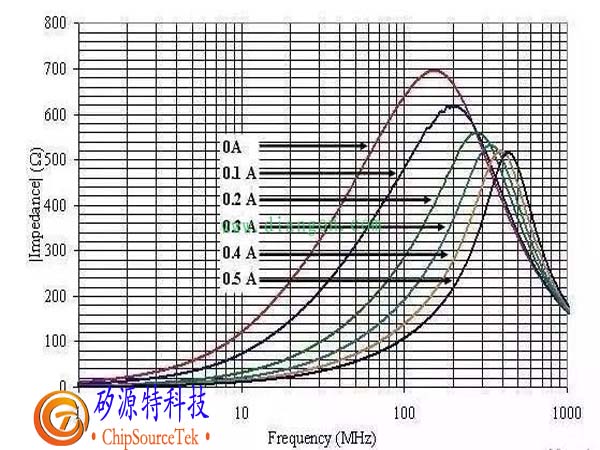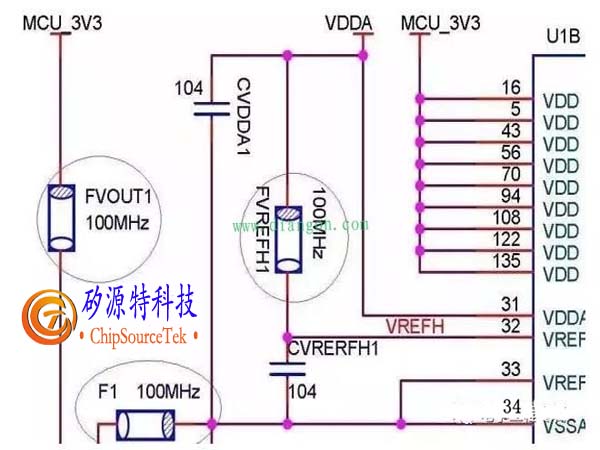Method of Selecting Magnetic Beads in Circuit Design
Time:2023-09-10
Views:611
The reason for using SMD magnetic beads and SMD inductors: Whether to use SMD magnetic beads or SMD inductors mainly depends on the application. Chip inductors are required in resonant circuits. When it is necessary to eliminate unnecessary EMI noise, using SMD magnetic beads is the best choice.


1. The unit of magnetic beads is ohms, not Hunter, which requires special attention. Because the unit of magnetic beads is nominal based on the impedance it generates at a certain frequency, and the unit of impedance is also ohms. The DATASHEET of magnetic beads usually provides characteristic curves of frequency and impedance, usually based on 100MHz, such as 1000R 100MHz, which means that the impedance of magnetic beads is equivalent to 600 ohms at 100MHz.
2. A regular filter is composed of lossless reactance components, and its function in the circuit is to reflect the stopband frequency back to the signal source, so this type of filter is also called a reflection filter. When the reflection filter does not match the impedance of the signal source, a portion of energy will be reflected back to the signal source, causing an increase in interference level. To solve this problem, a ferrite magnetic ring or bead sleeve can be used on the inlet line of the filter, and the eddy current loss of the high-frequency signal caused by the ring or bead can be utilized to convert the high-frequency component into heat loss. Therefore, magnetic rings and beads actually absorb high-frequency components, so they are sometimes referred to as absorption filters.
Different ferrite suppression elements have different optimal suppression frequency ranges. Usually, the higher the magnetic permeability, the lower the frequency of suppression. In addition, the larger the volume of ferrite, the better the inhibitory effect. Some online studies have found that when the volume is constant, long and thin shapes have better inhibitory effects than short and thick shapes, and the smaller the inner diameter, the better the inhibitory effect. However, in the case of DC or AC bias currents, there is also a problem of ferrite saturation. The larger the cross-sectional area of the suppression element, the less likely it is to be saturated, and the greater the allowable bias current. When EMI absorbs magnetic rings/beads to suppress differential mode interference, its current value is directly proportional to its volume, and the imbalance between the two causes saturation, which reduces component performance; When suppressing common mode interference, the two wires (positive and negative) of the power supply are simultaneously passed through a magnetic ring, and the effective signal is a differential mode signal. EMI absorption of the magnetic ring/bead has no effect on it, while for common mode signals, it will show a large inductance. Another good method for using magnetic rings is to repeatedly wind the wires passing through the magnetic ring several times to increase the inductance. According to its principle of suppressing electromagnetic interference, its inhibitory effect can be reasonably used.
The ferrite suppression element should be installed near the interference source. For input/output circuits, they should be located as close as possible to the inlet and outlet of the shielding shell. For the absorption filter composed of ferrite magnetic rings and beads, in addition to selecting high permeability lossy materials, attention should also be paid to its application occasions. Their resistance to high-frequency components in the circuit is approximately ten to several hundred Ω, so their role in high impedance circuits is not significant. On the contrary, their use in low impedance circuits (such as power distribution, power supply, or RF circuits) will be very effective.
Due to its ability to attenuate higher frequencies while allowing lower frequencies to pass almost unobstructed, ferrite has been widely used in EMI control. Magnetic rings/beads used for EMI absorption can be made into various shapes and widely used in various occasions. If on a PCB board, it can be added to DC/DC modules, data cables, power cables, etc. It absorbs high-frequency interference signals on the line where it is located, but it does not generate new zeros and poles in the system and does not disrupt the stability of the system. It can be used in conjunction with a power filter to effectively supplement the shortcomings of the high-frequency performance of the filter and improve the filtering characteristics in the system.

Magnetic beads are specifically designed to suppress high-frequency noise and peak interference on signal and power lines, and also have the ability to absorb electrostatic pulses.
Magnetic beads are used to absorb ultra-high frequency signals, such as some RF circuits, PLLs, oscillation circuits, and circuits containing ultra-high frequency memory (DDR SDRAM, RAMBUS, etc.) that require magnetic beads to be added to the power input. Inductors are energy storage components used in LC oscillation circuits, medium and low frequency filtering circuits, and their application frequency range rarely exceeds 50MHz.
The main function of magnetic beads is to eliminate RF noise present in transmission line structures (circuits). RF energy is the AC sine wave component superimposed on the DC transmission level, and the DC component is the useful signal required. However, RF energy is useless electromagnetic interference transmitted and radiated along the line (EMI). To eliminate these unnecessary signal energy, a patch magnetic bead is used to act as a high-frequency resistor (attenuator), which allows DC signals to pass through while filtering out AC signals. Usually, high-frequency signals are above 30MHz, however, low-frequency signals can also be affected by SMD magnetic beads.
SMD magnetic beads are composed of soft ferrite materials, forming a high volume resistivity monolith structure. The eddy current loss is inversely proportional to the resistivity of ferrite materials. The eddy current loss is proportional to the square of the signal frequency. The benefits of using SMD magnetic beads: miniaturization and lightweight have high impedance in the frequency range of RF noise, eliminating electromagnetic interference in transmission lines. Closed magnetic circuit structure, better eliminating signal string winding. Excellent magnetic shielding structure. Reduce the DC resistance to avoid excessive attenuation of useful signals. Significant high-frequency and impedance characteristics (better elimination of RF energy). Eliminating parasitic oscillations in high-frequency amplification circuits. Effective operation in the frequency range of several MHz to several hundred MHz.

Several suggestions for choosing the core of magnetic beads correctly:
1、 What is the frequency range of unnecessary signals;
2、 Who is the noise source;
3、 Is there space to place magnetic beads on the PCB board;
4、 How much noise attenuation is required;
5、 What are the environmental conditions (temperature, DC voltage, structural strength);
6、 What is the circuit and load impedance;
The first three can be determined by observing the impedance frequency curve provided by the manufacturer. In the impedance curve, all three curves are very important, namely resistance, inductance, and total impedance. The total impedance is described by ZR22 π fL() 2+:=fL. Through this curve, select the magnetic bead model that has the maximum impedance within the frequency range of desired noise attenuation and minimizes signal attenuation at low frequencies and DC. Under excessive DC voltage, the impedance characteristics of SMD magnetic beads will be affected. In addition, if the operating temperature rises too high or the external magnetic field is too large, the impedance of the magnetic beads will be adversely affected. You can also choose at the Shenzhen Electronics Exhibition. The reason for using SMD magnetic beads and SMD inductors: Whether to use SMD magnetic beads or SMD inductors mainly depends on the application. Chip inductors are required in resonant circuits. When it is necessary to eliminate unnecessary EMI noise, using SMD magnetic beads is the best choice.
Application scenarios for SMD magnetic beads and SMD inductors:
Chip inductance: Radio frequency (RF) and wireless communication, information technology equipment, radar detectors, automobiles, cellular phones, pagers, audio devices, PDAs (personal digital assistants), wireless remote control systems, and low-voltage power supply modules.
Chip magnetic beads: filtering between clock generation circuits, analog and digital circuits, I/O input/output internal connectors (such as serial ports, parallel ports, keyboards, mice, long-distance telecommunications, local area networks), radio frequency (RF) circuits, and logic devices that are susceptible to interference, filtering out high-frequency conducted interference in power supply circuits, and suppressing EMI noise in computers, devices, video recorders (VCRS), television systems, and mobile phones.
|
Disclaimer: This article is transferred from other platforms and does not represent the views and positions of this site. If there is any infringement or objection, please contact us to delete it. thank you! |











